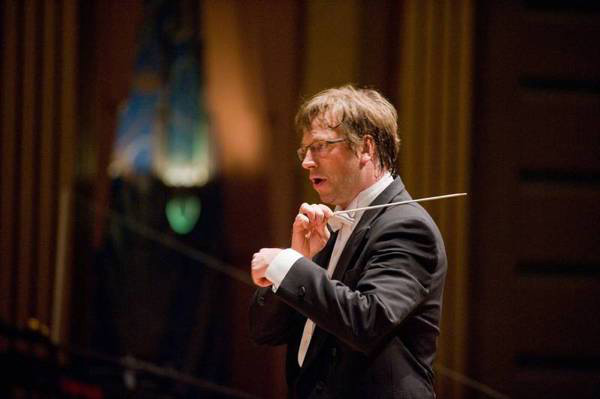If anyone foolishly thought the selection process for finding the next music director of the Knoxville Symphony Orchestra was going to be an easy, or obvious one, the appearance this week of guest conductor Eckart Preu, the fourth of six candidates this season, certainly changed their mind. Preu’s selected program—works by Richard Strauss, Mozart, Jennifer Higdon, and Sergei Prokofiev—highlighted, in no uncertain terms, his strength as a master of flow, orchestral texture, and dynamics. Even more rewarding, though, was seeing the orchestra itself adjust brilliantly to the differing personality, technique, and interpretative sensitivity brought by Preu, resulting in a masterful and wildly entertaining performance.
Even before a single note was played, Eckart demonstrated in his preface to the evening’s works one endearing quality that none of the previous candidates have so far revealed—a sense of humor. Of course, not everyone can pull off ironic wit and gentle satire, but Preu seems to be comfortable with it. In my Knoxville Mercury profile of Preu, he offered “Classical music can be very serious, but also a lot of fun…Humor is an essential counterpart to emotional depth – and I think both benefit from each other.”
Acknowledging the evening’s abstract theme of love in various forms, Preu opened the evening with Richard Strauss’ early tone poem, Don Juan. This work neatly challenges not only the orchestra as an ensemble, but also its sections and soloists. In Friday evening’s performance, Preu swept the orchestra along, somewhat breathlessly, with just enough punctuation on each passage without losing the momentum. Not at all breathless, thankfully, was the KSO horn section— led by principal Jeffery Whaley—that was both powerfully accurate and gorgeously luminous, especially in the familiar and quintessential Don Juan theme. Notable, too, was the gently descriptive passage played by principal oboe Claire Chenette.
Although the key of D minor is the key of Mozart’s Requiem and his Don Giovanni, its use in Mozart’s Piano Concerto No. 20 seems to take on a different abstract quality than tragedy—one of hopefulness for love, or perhaps even a yearning for spring in the midst of winter. Pianist Alon Goldstein, who joined Preu and the orchestra for that concerto, probably feels the same. His genuine and loving take on the subtleties of the work, particularly in the second Romance movement, was hopeful, yet questioning, as if probing for answers. Preu beautifully moderated the balanced storytelling between the pianist and the orchestra, allowing Mozart’s conversations between the instruments to be distinct yet part of the whole.
On the downside, I was surprised by a number of subtle lapses in accuracy by the pianist, and not in sections that were specifically challenging. Oddly, too, this is a work Goldstein apparently plays regularly and has spoken about fondly, yet he referred to sheet music throughout. One specifically awkward moment came at the end of the second movement where turning the page to prepare for the third Rondo movement, caused him to rush the final poignant phrase a bit.
All was easily forgiven as Goldstein electrified the audience with an encore—one of Alberto Ginastera’s Danzas Argentinas, the Danza del gaucho matrero. Goldstein’s ability to keep clean melodies flowing against the fortissimo heat and often savage dissonance was simply sublime.
After intermission, Preu and the orchestra turned to Jennifer Higdon’s blue cathedral, a work from 1999 written in memory of her brother who passed away suddenly from a virulent form of skin cancer. This ethereal work seems to float higher and higher thanks to a feast of percussion textures and effects including Chinese reflex balls taken up by a number of the orchestra players, plus the rubbed rims of tuned crystal glasses by the horn section. The ascent is controlled, though, by the reality and solidity of strings and woodwinds in moments of softness and in moments of grief and anger. The flute and clarinet—instruments played by Higdon and her brother—feature prominently in the work’s texture, beautifully taken in this case by KSO principal flute Nicholas Johnson and principal clarinet Gary Sperl.
I admit that I originally questioned the validity of ending the concert with selections from Prokofiev’s first two suites of music from his ballet score for Romeo and Juliet. Would there be a sense of cohesive intent and direction? Would the “Romeo at the Grave of Juliet” sell as the conductor’s final statement?
I shouldn’t have worried. Preu gave the selections a believable continuity of sorts, and imparted a design and energy that likewise pulled an energetic response from the orchestra. The contrasts that exist in the movements had a painterly feel as if they were visible and tangible products of the conductor and players—from the dissonant violence of “Death of Tybalt” to the inevitable dramatic tragedy of “Romeo at the Grave of Juliet.” What seemed to be obvious was that conductor and orchestra had developed a unity of purpose, a chemistry, that took the performance to another level. I doubt that any candidate for the KSO music director position could have hoped for more.
After January’s snowstorm scare and the resulting sparse crowd for the Masterworks concert, it was genuinely heartwarming to see impressively large and intensely interested audiences at both performances this month. Although I don’t have concrete data to support it, my observation and gut feeling is that there has been a positive, if gradual, demographic change in the orchestra’s audience, something that surely bodes well for whomever becomes the next KSO music director. Time will tell.








